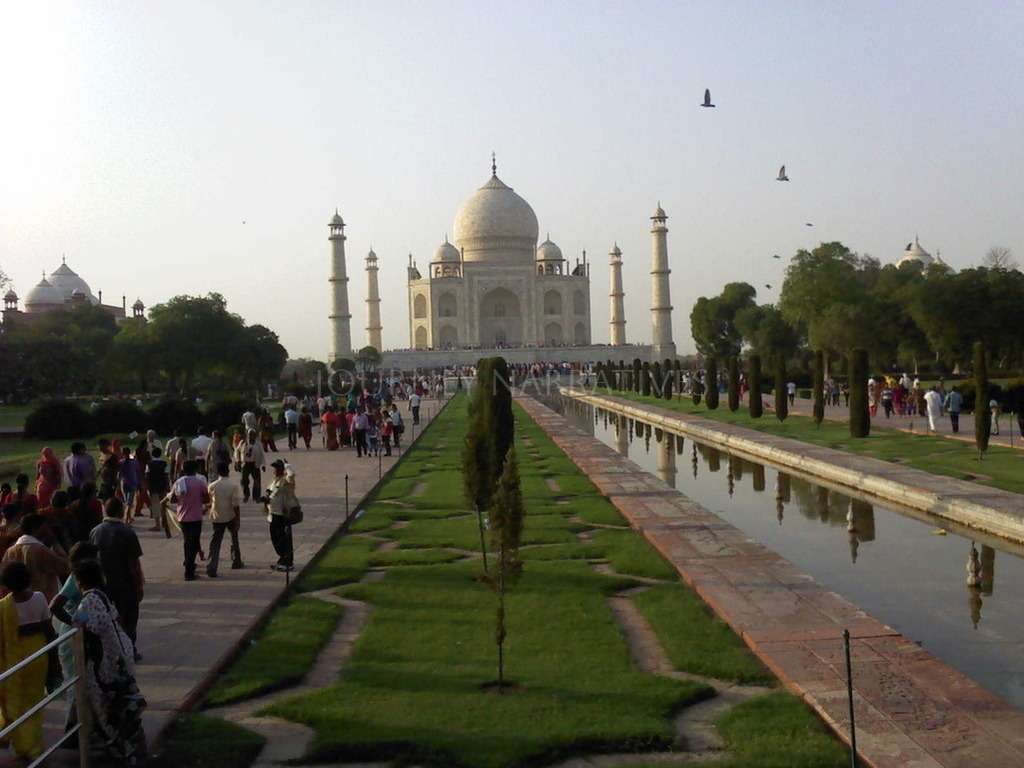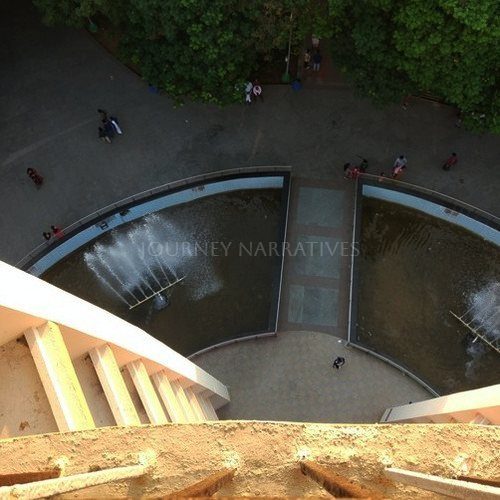India, with its deep-rooted history, diverse landscapes, and vibrant cultures, is home to an impressive collection of UNESCO World Heritage Sites. These sites are recognized for their cultural, natural, and mixed significance, preserving the incredible stories of ancient civilizations, architectural marvels, and natural wonders.

As of 2025, India has 42 UNESCO World Heritage Sites, making it one of the countries with the most heritage sites in the world.
Table of Contents
Let’s explore the list of these extraordinary sites, categorized into Cultural, Natural, and Mixed heritage sites.
Cultural World Heritage Sites in India
These sites showcase India’s architectural brilliance, historical significance, and cultural heritage.
Agra Fort (Uttar Pradesh)
Agra Fort, located in Uttar Pradesh, is a grand 16th-century red sandstone fortress built by the Mughal emperor Akbar. This UNESCO World Heritage Site, known for its stunning architecture and historical significance, served as the main residence of the Mughal emperors for several generations. With its majestic gates, towering walls, and intricate carvings, Agra Fort offers a glimpse into the opulence of the Mughal era. It also houses several important structures, including the Jahangir Palace, Diwan-i-Aam, and the exquisite Shah Jahan’s marble mosque. A must-visit for history and architecture enthusiasts, Agra Fort stands as a testament to India’s rich cultural heritage.

Ajanta Caves (Maharashtra)
The Ajanta Caves are ancient rock-cut Buddhist monuments dating back to the 2nd century BCE. These caves, known for their intricate paintings and sculptures, depict the life of Buddha and various Buddhist teachings. The stunning murals and carvings in these caves are masterpieces of ancient Indian art and a significant part of India’s cultural heritage.
Ellora Caves (Maharashtra)
The Ellora Caves represent a unique blend of Hinduism, Buddhism, and Jainism, with 34 rock-cut temples carved into volcanic rock. These awe-inspiring structures, built between the 5th and 10th centuries, showcase elaborate sculptures and intricate architecture, including the renowned Kailasa Temple, the world’s largest monolithic structure.
Taj Mahal (Uttar Pradesh)
The Taj Mahal, a symbol of eternal love, is a breathtaking white marble mausoleum built by Mughal Emperor Shah Jahan in memory of his wife Mumtaz Mahal. This one of the UNESCO World Heritage Sites, with its stunning architecture, lush gardens, and reflecting pools, is a masterpiece of Mughal art and one of the world’s most iconic landmarks.

Sun Temple, Konark (Odisha)
The Sun Temple at Konark, built in the 13th century, is a monumental chariot-shaped temple dedicated to the Sun God. The intricate carvings on its walls and the massive wheels of the chariot reflect the temple’s astronomical significance and the grandeur of ancient Indian architecture.
Group of Monuments at Mahabalipuram (Tamil Nadu)
The Group of Monuments at Mahabalipuram, dating from the 7th and 8th centuries, includes rock-cut temples, rathas (chariots), and bas-reliefs. These masterpieces of Dravidian architecture, carved from granite, are a testament to the artistic and architectural brilliance of the Pallava dynasty.

Kaziranga National Park (Assam)
Kaziranga National Park is a natural paradise, known for its rich biodiversity and a major conservation site for the endangered one-horned rhinoceros. Located in Assam, this UNESCO site is celebrated for its unique combination of natural beauty and cultural preservation, attracting wildlife enthusiasts from around the world.
Fatehpur Sikri (Uttar Pradesh)
Fatehpur Sikri, the former capital of Mughal Emperor Akbar, is a Mughal architectural wonder. This fortified city, built in the late 16th century, is a beautiful blend of Indo-Islamic architecture, featuring grand palaces, mosques, and gateways that reflect the empire’s cultural diversity and grandeur.

Churches and Convents of Goa
The Churches and Convents of Goa, including the famous Basilica of Bom Jesus, represent the rich Portuguese colonial legacy. These beautiful churches and convents, built in the 16th and 17th centuries, are a remarkable example of Portuguese architecture and religious art in India.
Khajuraho Group of Monuments (Madhya Pradesh)
The Khajuraho Group of Monuments is one of the UNESCO World Heritage Sites famous for its exquisite sculptures that depict human life, including erotic art. Built between 950 and 1050 CE, these temples, with their detailed carvings and intricate architecture, showcase the creative genius of the Chandela dynasty.
Group of Monuments at Hampi (Karnataka)
The Group of Monuments at Hampi is a remarkable archaeological site showcasing the grandeur of the Vijayanagara Empire. The ruins of temples, palaces, and other structures, built in the 14th to 16th centuries, reflect the Dravidian architectural style and provide a glimpse into India’s medieval history.

Group of Monuments at Pattadakal (Karnataka)
The Group of Monuments at Pattadakal features a blend of North and South Indian architectural styles. Built between the 7th and 8th centuries, the temples here represent the peak of Chalukya architecture and are known for their intricate carvings and striking structural designs.
Elephanta Caves (Maharashtra)
The Elephanta Caves, located on an island near Mumbai, feature rock-cut sculptures and temples dedicated to Hindu deities, primarily Lord Shiva. The cave complex, dating back to the 5th to 8th centuries, is renowned for its massive sculptures, including the Trimurti, a 20-foot depiction of Shiva.
Great Living Chola Temples (Tamil Nadu)
The Great Living Chola Temples, including the Brihadeeswarar Temple (Thanjavur), Gangaikonda Cholapuram, and Airavatesvara Temple at Thanjavur, are magnificent examples of Dravidian architecture. Built by the Chola dynasty, these temples are a testament to the artistic and architectural prowess of medieval South India and continue to serve as active places of worship.
Buddhist Monuments at Sanchi (Madhya Pradesh)
The Buddhist Monuments at Sanchi are some of the oldest stone structures in India, dating back to the 3rd century BCE. Known for their stupas, monasteries, and exquisite carvings, these monuments represent the early stages of Buddhist art and architecture in India.
Humayun’s Tomb (Delhi)
Humayun’s Tomb in Delhi is an architectural masterpiece that served as the inspiration for the Taj Mahal. Built in the 16th century, this tomb, surrounded by lush gardens and beautiful Mughal architecture, marks the beginning of the Mughal Empire’s distinctive architectural style.

Qutub Minar and its Monuments (Delhi)
The Qutub Minar, a towering 73-meter-high structure built in the 12th century, is a remarkable example of Indo-Islamic architecture. The complex surrounding the minaret includes several other monuments, reflecting the grandeur of Delhi’s medieval architectural heritage.
Red Fort Complex (Delhi)
The Red Fort Complex, built by Mughal Emperor Shah Jahan in the 17th century, is a grand fort that served as the Mughal emperor’s main residence. Its massive walls, intricate architecture, and historic significance make it a key symbol of India’s Mughal era and UNESCO World Heritage Sites.
Mountain Railways of India
The Mountain Railways of India, including the Darjeeling, Nilgiri, and Kalka–Shimla railways, are engineering marvels that pass through stunning landscapes. These railways, built during British colonial rule, offer scenic journeys through the Indian Himalayas, providing a unique travel experience.
Mahabodhi Temple Complex at Bodh Gaya (Bihar)
The Mahabodhi Temple Complex at Bodh Gaya is the sacred site where Lord Buddha attained enlightenment. This UNESCO site is an important pilgrimage destination for Buddhists worldwide and is known for its towering spire, peaceful atmosphere, and the ancient Bodhi Tree.
Rock Shelters of Bhimbetka (Madhya Pradesh)
The Rock Shelters of Bhimbetka are ancient cave paintings and rock shelters dating back to the Paleolithic era. These shelters, featuring prehistoric artwork, provide early evidence of human life and are a fascinating glimpse into ancient cultures in India.
Champaner-Pavagadh Archaeological Park (Gujarat)
Champaner-Pavagadh Archaeological Park, located in Gujarat, is a pre-Mughal Islamic city that includes forts, temples, and mosques. This UNESCO site offers a fascinating view of the architectural and cultural evolution of the region from the 8th century to the 16th century.
Chhatrapati Shivaji Terminus (Maharashtra)
Chhatrapati Shivaji Terminus in Mumbai is a historic railway station that beautifully combines Gothic and Indian architectural styles. Built in the 19th century, this UNESCO site stands as a symbol of Mumbai’s rich colonial history and is an important transportation hub.
Rani ki Vav (Queen’s Stepwell) (Gujarat)
Rani ki Vav is an intricately designed stepwell built in the 11th century in Gujarat. Known for its elaborate carvings and architectural brilliance, this UNESCO site serves as an example of ancient water conservation techniques and is a true marvel of engineering.
The Jantar Mantar (Jaipur, Rajasthan)
The Jantar Mantar in Jaipur, built in the 18th century, is an astronomical observatory featuring a collection of giant instruments used to measure time and study celestial bodies. Its massive structures and precision make it one of the most significant observatories of its time.

Hill Forts of Rajasthan
The Hill Forts of Rajasthan, including Chittorgarh, Kumbhalgarh, and Amber, are a series of fortresses built atop hills to protect Rajasthan’s kingdoms. These forts, known for their imposing architecture and strategic locations, represent the region’s rich history and military prowess.
Great Himalayan National Park (Himachal Pradesh)
The Great Himalayan National Park in Himachal Pradesh is a sanctuary of biodiversity, known for its stunning landscapes and rich flora and fauna. This UNESCO site is significant not only for its natural beauty but also for its efforts in preserving endangered species and ecosystems.
Victorian Gothic and Art Deco Ensembles of Mumbai
The Victorian Gothic and Art Deco Ensembles of Mumbai are architectural treasures that showcase the transformation of Mumbai’s skyline in the 19th and 20th centuries. These buildings reflect a blend of Western and Indian design influences and stand as monuments of the city’s colonial past.
Jaipur – The Pink City (Rajasthan)
Jaipur, also known as The Pink City, is renowned for its exceptional urban planning, stunning palaces, and historical forts. The city’s architectural brilliance, characterized by its pink-painted buildings, makes it a prime example of royal Rajasthan’s grandeur.
Dholavira: A Harappan City (Gujarat)
Dholavira, an ancient city of the Indus Valley Civilization, is an archaeological marvel in Gujarat. The site features well-planned urban infrastructure, advanced water management systems, and intricate architecture, offering valuable insights into one of the world’s oldest civilizations.
Kakatiya Rudreshwara Temple (Ramappa Temple) (Telangana)
The Kakatiya Rudreshwara Temple, also known as Ramappa Temple, is a stunning sandstone temple in Telangana, built during the 13th century. Known for its exquisite architecture and intricate carvings, it stands as a testament to the brilliance of Kakatiya-era craftsmanship.
Natural World Heritage Sites in India
These sites represent India’s natural beauty and ecological significance.
Kaziranga National Park (Assam)
Kaziranga National Park, located in Assam, is renowned for its population of one-horned rhinoceroses. This one of the UNESCO World Heritage Sites is home to diverse wildlife, including tigers, elephants, and wild buffalo, and is recognized for its rich biodiversity and conservation efforts. The park’s lush grasslands and wetlands make it a paradise for wildlife enthusiasts and photographers alike.

Keoladeo National Park (Rajasthan)
Keoladeo National Park, located in Rajasthan, is one of the most significant bird sanctuaries in India. It serves as a haven for migratory birds, especially during the winter months. This one of the UNESCO World Heritage Sites boasts a diverse range of avian species, making it a must-visit destination for birdwatchers and nature lovers.
Manas Wildlife Sanctuary (Assam)
Manas Wildlife Sanctuary, situated in Assam, is a UNESCO Natural World Heritage Site and a Project Tiger reserve. This sanctuary is known for its rich biodiversity, including endangered species like the Bengal tiger, one-horned rhinoceros, and the golden langur. The park’s scenic landscapes, including grasslands and dense forests, provide a haven for wildlife and a sanctuary for conservation.

Nanda Devi and Valley of Flowers National Parks (Uttarakhand)
The Nanda Devi and Valley of Flowers National Parks in Uttarakhand are famed for their breathtaking alpine meadows and the sacred Nanda Devi peak. This UNESCO World Heritage Site is home to a stunning variety of flora and fauna, including rare species of plants and animals. The Valley of Flowers is particularly known for its vibrant floral diversity, attracting nature enthusiasts and trekkers.
Sundarbans National Park (West Bengal)
Sundarbans National Park in West Bengal is the largest tidal halophytic mangrove forest in the world and a vital habitat for the Royal Bengal Tiger. This UNESCO World Heritage Site is a complex ecosystem of rivers, tidal waterways, and mudflats, offering shelter to a wide variety of wildlife, including crocodiles, dolphins, and various bird species.

Western Ghats
The Western Ghats, stretching across several states in southern India, are known for their extraordinary biodiversity and the presence of numerous endemic species. This UNESCO World Heritage Site is home to a range of flora and fauna, including tigers, elephants, and the Malabar grey hornbill, making it a significant area for wildlife conservation.
Great Himalayan National Park (Himachal Pradesh)
The Great Himalayan National Park, located in Himachal Pradesh, is a UNESCO World Heritage Site famous for its exceptional biodiversity. The park is rich in flora and fauna, including rare species such as the Himalayan Monal and the Snow Leopard. It is celebrated for its stunning landscapes, ranging from alpine meadows to dense forests, and its role in preserving endangered species.
Khangchendzonga National Park (Sikkim)
Khangchendzonga National Park, named after Mount Khangchendzonga, the third-highest mountain in the world, is located in Sikkim. This UNESCO World Heritage Site is known for its diverse landscapes, from lush valleys to snow-capped peaks. The park is rich in biodiversity, with numerous species of plants and animals, and holds significant cultural and religious importance for the local communities.

Mixed World Heritage Site in India
Khangchendzonga National Park (Sikkim)
The only mixed heritage site in India for its spiritual, cultural, and natural significance.
| Type | Number of Sites |
|---|---|
| Cultural | 34 |
| Natural | 7 |
| Mixed | 1 |
| Total | 42 |
Plan your Travel
Many of these sites are easily accessible by road, rail, or air. Travel responsibly, respect local customs, and follow conservation guidelines.

India’s World Heritage Sites are not just monuments or natural parks – they are windows into the soul of the country. Whether you’re an adventurer, a history buff, a photographer, or a curious traveler, exploring these sites is a journey through time and nature.
Some of the links on this blog are affiliate links. This means I may earn a small commission if you make a purchase through these links, at no extra cost to you. This helps support the blog and allows me to create more valuable content. Thank you for your support!






